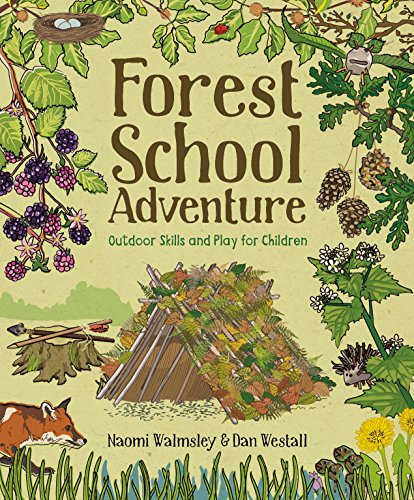From Living Woods Issue 49
CORINNE MOSS, Teaching Trees Officer at the
Royal Forestry Society, reviews Forest School Adventure.
 FOREST SCHOOL ADVENTURE
FOREST SCHOOL ADVENTURE
Naomi Walmsley and Dan Westall
GMC Publications
Inspired by their extensive experience
of delivering bushcraft sessions and of
living for five months in the wild with
no modern resources, authors Naomi
and Dan have packed this book full
of ideas of how to stimulate a love of
nature and adventure in kids of all ages,
and probably adults too.
The book is a beautifully presented
and easy to use resource, ideal for
teachers, scout or youth group
leaders, as well as parents. It is divided
into sections on nature awareness,
bushcraft, wild food and games, and
each activity has recommended age
ranges and gives the time, tools and
resources needed to complete it. The
simple instructions are illustrated with
superb step-by-step photographs and
ideas of how to extend or adapt each
activity. Even for those with limited
experience, this guide is enough to
encourage any leader to take children
outside to discover the wonders of
nature.
The first section of the book, Nature
Awareness, includes forest school
classics such as building bug
hotels, bird feeders and natural arts
and crafts. Whilst this section will
appeal particularly to those who are
new to forest school or outdoor
education, there are plenty of twists
on familiar activities to give more
experienced practitioners some new
ideas. The 3D natural map hide and
seek game will definitely be one that
we will be trying out.
Moving on to more adventurous
activities, section two looks at
bushcraft. Den building is an all-time
favourite, but Naomi and Dan’s dens
are not your average stick lean-tos.
They demonstrate different kinds
of structures and show you how to
turn a makeshift den into something
which can really protect you from the
elements and that you can sleep in.
And for lashing your sticks together,
or tying down a tarpaulin, you’ll need
to know how to tie knots properly, so
that’s all in there too. This section also
covers all aspects of survival, including
water collection, different ways to light
fires, first aid, use of knives and even
primitive skills such as arrow making.
If all that sounds a bit scary for trying
with kids, don’t worry there’s plenty of
safety guidance included too.
Once you’ve learnt how to set up
camp, you’ll need to eat, which leads
nicely onto section three which is all
about wild food. Knowing what is safe
and legal to forage
and what to avoid is vitally important,
and with the advice in this section you
can’t go wrong. Clear photographs
are included for identification and the
suggested plants should be easy to find.
There are enough recipes to muster up
a feast and kids will have great fun with
things like toasting their home-made
bread twists over the fire and baking
inside fruit skins. For older children
– and braver leaders – there’s even
full instructions on how to catch and
prepare a trout.
The final section of the book is all
about games. Having fun outdoors is
what really makes children love and
want to protect their wild spaces, and
for many of us it helped shape our
future careers. There are lots of new
ideas for games in this section, which
will get children moving, let them be
silly and help them work together as
teams. It’s a lovely conclusion to the
book.
This book provides everything from
the basics of taking children outdoors
for short and easy sessions, to real
challenges which will not only teach
them about nature but will fill them
with a sense of achievement. It is a
book which should be in every school
staff room and has plenty to inspire
anyone with children to ditch the
technology and go out and explore!